#philippa of hainault
Explore tagged Tumblr posts
Text
No, I’m not racist, I just think that people should stop trying to find the smallest, most fading drop of supposed African ascendency / features in queens like Philippa of Hainault or Charlotte of Meckleburg-Strelitz and start focusing in ACTUAL black nobility. I beg you who do this to stop spreading misinformation like “Philippa of Hainault was the first black queen” in the internet because that is almost as harmful as whitewashing and people may actually believe your statements. Try to learn about queen Nzinga of Ndongo or the emperors and empresses of Haiti, which were fairly very interesting, instead of deliberately spreading blatant lies.
7 notes
·
View notes
Note
I often see the saying that Queen Anne Philippa of Hainault of Bohemia doesn't care about politics? Unlike Isabella from France, they are very boring... What do you think?
I think whoever is saying this is lucky that Richard II, at least, is dead because they'd probably be catching hands off him (or taking a cane to the face). I have little doubt that Edward III would join in or that Philippa of Hainault would bend them into a pretzel. "Very boring", good God, no.
This is an old and outdated view of medieval queenship. Historians have been pushing back against the view of the one lone exceptional woman who is politically active and involved while the rest were a bunch of dumb-dumbs who only cared about pushing out babies and if their husband really, truly loved them for years. Years! There has been a lot of work on Philippa and Anne specifically that have focused on how they exercised the office of queenship, how they were politically involved and active, and how this was the norm for them. Recent evaluations of Isabella of France have also tended to argue that she was an entirely conventional queen until her situation made her step outside the bounds of conventional queenship, rather than she-wolfing it up the moment she arrived in England.
If you want to read more about this, I'd suggest looking at the following:
Heather J. Tanner, Laura L. Gathagan and Lois L. Huneycutt, "Introduction" in Medieval Elite Women and the Exercise of Power, 1100–1400: Moving beyond the Exceptionalist Debate (Palgrave 2019)
Kristen L. Geaman, Anne of Bohemia (Lives of Royal Women, Routledge 2022)
Kristen L. Geaman, "Beyond Good Queen Anne: Anne of Bohemia, Patronage, and Politics" in Medieval Elite Women and the Exercise of Power, 1100–1400: Moving beyond the Exceptionalist Debate (Palgrave 2019)
Kristen L. Geaman, "Anne of Bohemia: Overcoming Infertility" in Later Plantagenet and the Wars of the Roses Consorts: Power, Influence, and Dynasty (Palgrave 2023)
Michael Evans, "Isabella of France: She-Wolf and Rebel Queen?" in Later Plantagenet and the Wars of the Roses Consorts: Power, Influence, and Dynasty (Palgrave 2023)
W. Mark Ormrod, "Philippa of Hainault: Dignity, Duty, and Display", in Later Plantagenet and the Wars of the Roses Consorts: Power, Influence, and Dynasty (Palgrave 2023)
Lisa Benz St. John, Three Medieval Queens: Queenship and the Crown in Fourteenth-Century England (Palgrave 2012)
Louise Tingle, Chaucer's Queens: Royal Women, Intercession and Patronage in England, 1328-1394 (Palgrave 2020)
Anna M. Duch, "Anne of Bohemia: A Political Post-Mortem", Paper given at the 52nd International Congress of Medieval Studies at Western Michigan University (2017), available on academia.edu
Jordan Schoonover, ‘“Wishing to Defend Her Country”: Philippa of Hainaut, Royal Marital Partnership, and the Battle of Neville’s Cross (1346)’, Royal Studies Journal, 10(2)
Theresa Earenfight, "Where Do We Go From Here? Some Thoughts on Power and Gender in the Middle Ages." Medieval Feminist Forum: A Journal of Gender and Sexuality 51, No. 2 (2016)
These are all great resources but I especially recommend reading Kristen Geaman's biography of Anne, as not only is it a really good overview and reassessment of Anne, it's also a really great study of exactly how queenship worked and how a politically active queen was the norm.
27 notes
·
View notes
Text
Directly linked to the failure of the war effort was the idea that after Philippa’s death Edward III descended into a second youth. [...]
Philippa was central to Edward’s assumption of his adult kingship. Her coronation in February 1330 and the birth of Edward of Woodstock later the same year allowed Edward at the age of seventeen to break from his controversial mother and her lover and assert his own, independent royal family as a husband, father and a man. Philippa and his family, therefore, formed the foundation of his adult reign and they continued to be at the heart of kingship throughout his reign. [...]
In contrast, Edward’s relationship with Alice had the opposite effect. Their lustful affair had all the connotations of a youthful dalliance. This youthfulness was reinforced by Edward’s inability to demonstrate his manly vigour either on the battlefield or by proxy through the success of his armies in the field. More than anything, the lapse in Edward’s moral strength of character to conquer his passions for Alice meant that he was perceived as lacking the strength of character to perform wise, consistent, just and manly kingship needed to rule effectively. Instead his behaviour was that of a boy, indulgent, weak willed and inconsistent, prone to flattery and ruled by inappropriate council.
Moreover, this was much worse in an older man because while a youth could grow into a man, for a man to change into a youth went against the natural order of life. Thus, Edward was transformed from the hero of Crécy and Poitiers to the stock literary character of a pathetic old man infatuated and distracted by a young temptress, such as in the king in Chaucer’s Merchant’s Tale. Walsingham crystallises this image of a senile old king by declaring Edward’s relationship with her as a form of madness, as ‘a lecherous youth sins, but a lecherous old man is insane’.
This image of a pathetic old man driven only by his own desires and those of his mistress played a large part in the perception that Edward III was conquered by his love for Alice and was therefore the subordinate partner in their relationship. In addition to his comment that it is unnatural that ‘a woman should rule the land and should subject the king to serve her in the Mirour de l’Omme, Gower recalls a story in the bible of a king who asked four of his courtiers what was the fullest strength. The second of these responded:
That women are stronger than him [the king]; Because women know how to subjugate the king; We see an example of this everyday, Many a king is in this great malady, For hardly anyone knows how to protect himself.
In similar terms, Walsingham declared that the king should be considered a slave rather than a lord when he allows himself to be commanded by such a shameless woman. Therefore, whereas Edward III’s marriage to Philippa made his kingship complete and proved him to be a man ready to rule his kingdom, inversely the death of his queen and his indulgence of a younger mistress projected the image of a frivolous king, enjoying a lustful second youth and the inability to govern that went with it.
— Laura Tompkins, The Uncrowned Queen: Alice Perrers, Edward III and Political Crisis in Fourteenth-Century England, 1360-1377 (PhD Thesis, University of St Andrews, 2013)
#“We see an example of this everyday” lmfaoo#Edward III#Philippa of Hainault#Alice Perrers#english history#14th century#my post
9 notes
·
View notes
Text
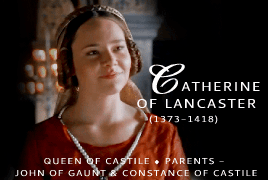
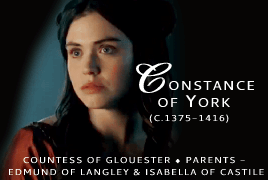

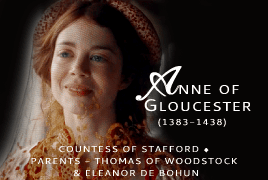
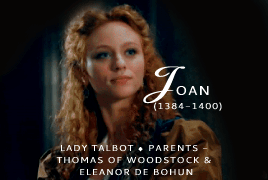

ROYALTY MEME | Granddaughters of Edward III & Philippa of Hainault (part two) / (part one)
through their sons: John of Gaunt, Edmund of Langley, and Thomas of Woodstock
#historyedit#historicwomendaily#catherine of lancaster#constance of york#joan beaufort#anne of gloucester#joan lady talbot#perioddramaedit#history#women in history#weloveperioddrama#onlyperioddramas#perioddramasource#cortegiania#userbennet#userperioddrama#edward iii#philippa of hainault#*royalty meme#my edit
109 notes
·
View notes
Text

Favorite Queen or Queen-adjacent medieval woman: Philippa of Hainault
"The most gentle Queen, most liberal, and most courteous that ever was Queen in her days."
It was difficult for me to choose a favorite, but in light of my recent hyperfixations on the impact of revisionist history, Bridgerton, and the modern concepts of race and identity, I felt like she really was the only one I could choose.
Phillipa is often touted as the perfect queen, similar to how Elizabeth of York is later portrayed. We know that she came to England during a very difficult and tumultuous time where her husband Edward III was a ruler in name only.
She was a patron of the arts and clearly intelligent, advising her husband in ways they could restore order after the financial strains the country had gone through. At one point she gathered the English army to face King David II of Scotland which resulted in his capture. Phillips even had a whopping thirteen children!
All of that is well and good, but the part of her so many people focus on these days is what she looked like.
There is a description of a girl, alleged by some to be Philippa, written by Bishop Stapleton during a visit to Flanders.
"The lady whom we saw has not uncomely hair, betwixt blue-black and brown… Her face narrows between the eyes and its lower part is more narrow than her forehead. Her eyes are blackish-brown and deep. Her nose is fairly smooth and even, save that it is somewhat broad at the tip and flattened, and yet it is no snub-nose… Her lips are full, especially the lower lip… Her lower teeth project a little beyond the upper; yet this is but little seen… All her body is well set and unmaimed; and nought is amiss so far as a man may see. Moreover, she is brown of skin all over, much like her father. And she will be of the age of nine years on St. John's day next to come, as her mother said. She is neither too tall nor too short for such an age; she is of fair carriage. The damsel is well taught in all that becometh her rank and highly esteemed and well beloved by her parents and of all her meinie, in so far as we could inquire and learn the truth. In all things, she is pleasant enough, as it seems to us"
*Note that "However, "Michael Prestwich's 2005 summary translates the description of the hair as "between blonde and brown" (the original is "entre bloy et brun"); Plantagenet England, 1225–1360 Clarendon, Oxford, 2005, p.215"
Now there's a lot of debate about this description - first and foremost, if it describes her at all. Ian Mortimer believes it describes her sister, Margaret, and wrote a rather angry response to the 100 Greatest Black Britons project including her as there was no evidence she was black "despite everything we know about them, their genetic background and culture of the period".
Whether or not it was Philippa, I do find it interesting that the historians who argue it is Margaret seem to miss what I think is a fairly obvious point: no matter which girl it was, they were full-blooded sisters and likely looked alike but also their father is described as having the same skintone.
In a time of a raceblind Hamilton cast, of Bridgerton, and My Lady Jane, I do think it's important that we acknowledge the importance of race throughout history - both how things were, and how they could have been if not for prejudice. I also believe it's important that we're mindful of the fact that there's a very modern perception that associates blackness with both skintone and originating from Africa at some point in time, so there's no way European royals could possess a darker skintone. Only it's not that simple.
The truth is there are no absolutes with history, especially history this old. We were not there. We cannot unravel the code of Philippa's genetics and state for certain what was there. We don't have a photograph. We don't even have paintings.
Hell, just look to how many people today are discovering their own history is a lie after taking a DNA test. The number of affairs exposed, secret adoptions, even incest is showing to be more prevalent than we believed. That's to say nothing of the expression of genetics and how a person might not "look" like the ethnicity they genetically are.
Philippa very well could have been "brown of skin all over, much like her father", or not.
In a modern society she might have considered herself to be black, or not.
The important thing is we should not take the current context of race and ethnicity and apply it to historical figures because we know they themselves did not think in such a manner.
It's fun to think about, and the discussions it brings up are worth having, but at the end of the day it's just supposition.
#medievalwomenweek#Philippa of Hainault#went on a tiny tangent#but I find it so fascinating how historians respond to the description
23 notes
·
View notes
Text
“Queen Philippa retains contacts with her native Hainault, and in Edward III has the benefit of a husband who dotes on her and supplies her with almost as many precious items and jewel-encrusted clothes as he orders for himself and his friends. If you should come across a lady wearing ‘a hood made of brown scarlet studded with 154 stars of pearls and trimmed with gold, each star being crafted out of seven large pearls with an especially large one at the top of each star,’ or ‘a beaver-fur hat lined with velvet and adorned with white pearls and golden baboons,’ have no doubt: she is a queen.”
— Ian Mortimer, The Time Traveler’s Guide to Medieval England (Touchstone, Simon & Schuster, 2008)
#philippa of hainault#historical fashion challenge 2025#historical fashion#medieval fashion#medieval history
8 notes
·
View notes
Note
I have read your one answer, which is shocking. Did Philippa of Hainault participate in the Battle of Neville's? Is the famous prayer a rumor, and ultimately what is true?
Participated as in took to the field and bore arms? No. But participated as in being involved in the preparations for the battle? Quite possibly.
Historians have generally been dismissive of the claim because they argued it was chronologically impossible and/or because Philippa's involvement, by virtue of her gender, was deemed absurd. However, Jordan Schoonover recently wrote an article about Philippa and the Battle of Neville's Cross and makes a convincing case that Philippa's involvement was neither impossible nor absurd.
In the first case, she argues that is only chronologically impossible if we assume Philippa was travelling only by land, not by water, and if she travelled by water, she could have easily made the distances in the time required. Schoonover also argues that historians have tended to assume Philippa was in Flanders by early October in order to meet with her sister, Margaret of Hainault - but the evidence for Philippa's presence there and the timing of her meeting with her sister is complicated by the possibility that business for Philippa was carried out by attorneys ahead of her actually being there.
Three chronicles record Philippa's involvement, including a Flemish chronicle that records Philippa and Margaret's meeting took place after the Battle of Neville's Cross. Moreover, Schoonover argues that Froissart, who is one of our chief sources for Philippa's involvement and counted Philippa as a patron, is unlikely to have recorded Philippa's involvement if it was obviously untrue, as it would be embarrassing for Philippa to be seen claiming credit for something she and everyone else knew she hadn't done.
Schoonover also notes a sexist double standard - historians do not need Edward III to physically take the field in order to accept him participating in a battle, so why do we need Philippa to do the same? She also notes that many historians have dismissed Philippa's potential involvement out of hand as a "fantasy", "a totally unreliable tradition … given unwarranted publicity", or an "inventive" story simply because of her gender. As Schoonover, notes, "if one dismisses the worthiness of accounts by the presence of women, it will be hard to untangle what actually happened from our own ideas about what was possible for medieval women".
(I would also argue that Philippa's reputation as an exemplar of medieval queenship, as a "conventional" queen who is stereotyped as as domestic, passive and politically uninvolved, is also at play. There are very few attempts to declare Margaret of Anjou's involvement in military matters an impossibility or a "fantasy".)
Regardless of whether Philippa was really involved in the Battle of Neville's Cross, the story that she was, Schoonover argues, tells us that it was far from unusual or transgressive for a queen to be involved in the defence of her country (particularly in the absence of the king).
I really recommend reading the article in full since this is a very, very quick summary of it.
I'm not sure what you mean by "famous prayer" - I'm guessing Philippa's intercession for the burghers at Calais? Again, we don't know for sure. Some chroniclers mention it (notably Froissart), some don't. Some chroniclers rarely, if ever, mention women so a chronicler not mentioning it doesn't necessarily mean it was an impossibility. We know Philippa probably wasn't pregnant at the time, much less heavily pregnant, since the timing wouldn't match up with the births of her known children - but that doesn't mean that her entire intercession was an invention.
I, personally, think it happened - as Schoonover says, it would be embarrassing for Philippa if Froissart gave her a huge, dramatic role when it was obviously untrue, and her interceding for the burghers would be entirely in keeping with expectations for her duties as queen.
11 notes
·
View notes
Text

Queen Philippa Interceding for the Lives of the Burghers of Calais
Artist: Benjamin West (British-American, 1738-1820)
Date: 1788
Medium: Oil on canvas
Collection: Detroit Institute of Arts, Detroit, Michigan, United States
Description
This painting depicts a scene from English history during the fourteenth-century siege at the French port of Calais by the English King Edward III. Dressed in white, Queen Philippa stands next to the armor-clad king with a hand outstretched toward several prisoners — the burghers, or leading citizens, of Calais. The burghers surrendered themselves to Edward, who promised to spare the populace of the city in exchange for their lives. Philippa intervened on their behalf, convincing the king to spare them in honor of their bravery and sacrifice.
American painter Benjamin West created two versions of this subject following a commission from British King George III. Since Edward III transformed the fortification at Windsor into a grand Gothic palace, the later king thought, “the achievements of his splendid reign [. . .] would prove very suitable ornaments to the halls and chambers of that venerable edifice.” West exhibited this version of the subject at the Royal Academy in 1788, and in 1789, completed a second version (Royal Collection Trust) for the Audience Chamber at Windsor.
#historical art#historical scene#oil on canvas#fourteenth century siege#french port of calais#king edward iii#queen philippa#armour#prisoners#the burghers#surrender#soldiers#helmet#men#women#children#ship#drapes#costume#crown#philippa of hainault#british american culture#british american art#benjamin west#british american painter#18th century painting#european art
9 notes
·
View notes
Text
"There is no doubt at all that Philippa of Hainault had deep maternal instincts and that she and Edward III created remarkably close relationships with their children. They had seven sons, of whom five survived to adulthood, and the king remained on close and affectionate terms with all of them throughout his life. Given the frequent pattern of hostility and rebellion on the part of royal sons towards their fathers throughout the Middle Ages, for Edward III to retain the love and loyalty of all his sons until he died was a real achievement that should not be underestimated and Philippa of Hainault was to a great extent responsible for the forging of affectionate ties between her husband and their children."
philippa of hainault: mother of the english nation, katheryn warner
25 notes
·
View notes
Text
PHILIPPA OF HAINAULT // QUEEN OF ENGLAND
“She was Queen of England as the wife and political adviser of King Edward III. She acted as regent in 1346, when her husband was away for the Hundred Years' War. After her husband reclaimed the throne, Philippa influenced King Edward to take interest in the nation's commercial expansion, was part of the successful Battle of Neville's Cross, and often went on expeditions to Scotland and France. She won much popularity with the English people for her compassion in 1347, when she successfully persuaded the King to spare the lives of the Burghers of Calais. This popularity helped maintain peace in England throughout their long reign.”


3 notes
·
View notes
Note
Hello Friend
Thoughts on Philippa of Hainault and Isabella Of Portugal?
I don’t really think about Philippa of Hainault if I am honest, but she seems to have been a good queen of great courage (as the affair of the burgers of Calais proved). She must have suffered very much the losses of so many of her children, and her husband cheating on her with Alice Perrers (but I think the Alice Perrers stuff is probably more deep than the “ambitious evil woman tricks the old good king over and over again”? In which case I’d artery not voice my opinion, as I am very uninformed on this particular matter and I would not like to say something untrue).
As for Isabella of Portugal, Duchess of Burgundy, I think she was a very interesting woman. The only surviving daughter of the “illustrious generation” (the vast progeny born to Joao of Avís and Philippa of Lancaster, kings of Portugal), she would have become her cousin Henry V’s queen had her mother not died suddenly from the plague, thusly ending the marriage negotiations; for years she lived at Sintra in a cultured court parallel to that of her father and brother, accompanied by many women who were well learned, until her marriage to Philip the Good at age thirty three, after being rejected once in her late twenties by him in favour of his widowed political aunt Bonne of Artois. Their marriage created the Order of the Golden Fleece, that survives to this day, under the motto “I will know no other but the dame Isabeau” (an oath he would, sadly, never fulfill). She was rather austere in opposition to the extravagant lavishness of the court of Burgundy, one of the most prosperous in Europe at the time, but she adapted well, and quickly gave the duke succession; three sons, of whom two died in infancy and almost one after the other, before she birthed Charles Martin, Count of Charolais. She instructed her son well, and she also brought up many other children, like Marie of Guelders and Isabelle of Bourbon, her husband’s young grandniece and niece. She also proved to be a wise matchmaker, arranging Marie’s marriage to the king of Scotland and Charles Martin’s marriage in childhood to Catherine, the daughter of the French king. When Catherine died at eighteen, leaving a very young Charles Martin widowed and childless at fourteen, she made the necessary arrangements to marry him again; the chosen one was a daughter of Richard of York, Anne. But the marriage was not meant to be, as her husband, opposed to an alliance with the English, decided instead to secretly marry Charles off to Isabelle, without the mother and the bridegroom’s previous knowledge. This bold move was met with great opposition by the duchess who, seeing her ambitions being met with indifference, refused to present her respects to the newly made Countess of Charolais, though they soon reconciled. She was there when her only granddaughter, Marie or Mary “The Rich”, was born, and she was there during her christening, and during Isabelle’s dying days. In the later years of her marriage, she chose to stay away from her husband’s court, a decision that her son supported, since both of them heavily disagreed with the duke’s excesses, but she would return to nurse him during his last years, after he suffered a stroke during a tennis match and died some years after. She lived to quite the ripe age, having seen her last ambition fulfilled when her son remarried to the sister of Anne of York, Margaret (whom she dearly loved, and whom she gave in inheritance some of her most beautiful states).
2 notes
·
View notes
Text

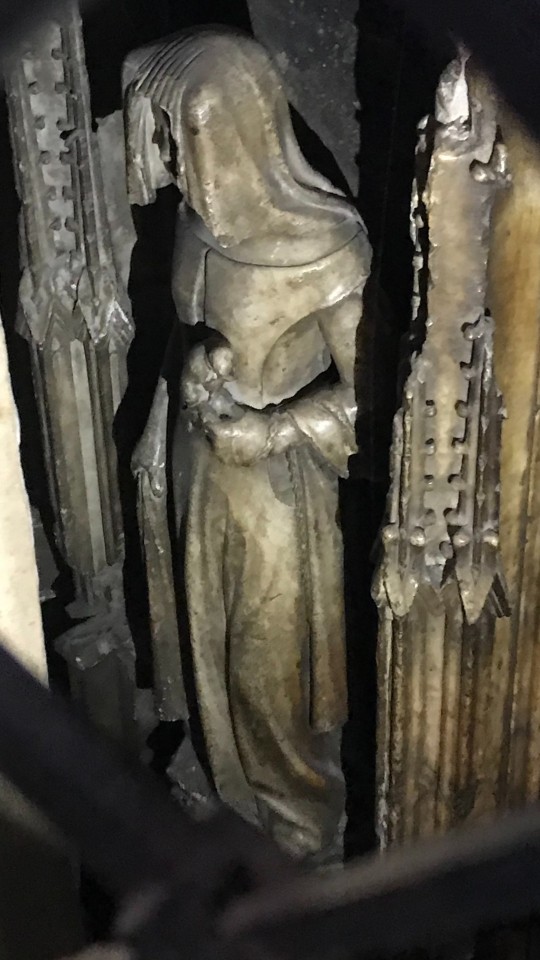
Weeper on Philippa of Hainault's tomb representing Blanche of Lancaster
The thirty-two statues of weepers (pleurants) made of alabaster that were placed around the tomb of the deceased queen are almost all lost. Only one pleurant, the statue of Philippa’s daughter-in-law, Blanche of Lancaster (d. 1369)*, is what is left from the original group. It was covered by masonry when the tomb of King Henry V was installed and discovered by Gilbert Scott during the nineteenth-century renovation of Westminster Abbey. Blanche is portrayed slightly bent forward, dressed in the latest fashion in an open sur-cotte. With her right hand she lifts the hem of her dress. The chain of the tiny pet monkey that sits on her arm is winded around her left hand. On the pedestal under the statue, her coat of arms is still visible. Sanne Frequin, "A monument for an English Queen: The genealogical programme on the tomb of Philippa of Hainault (d. 1369) at Westminster Abbey, London", Virtus 28 (2021) * Blanche died a year earlier, 12 September 1368, though this is a recent discovery.
#blanche of lancaster#philippa of hainault#westminster abbey#graves and tombs#historian: sanne frequin
14 notes
·
View notes
Note
I love love love you're art. The fashion ones are so fun to see and I love your portraits of historical figures! Have you ever thought of doing figures older than the War of the Roses like Anne of Bohemia or Philippa of Hainault?
Hello! :)
Thank you for the appreciation you give me! I am happy and very grateful for the fact that you like what I create!
Although I don't know - yet - very much about them, I can say that both Anne of Bohemia and Philippa of Hainault are personalities that arouse some interest in me. I did not focus on the pre-WOTR periods, apart from some information found here and there. So I can't answer your question concretely. What I can say, instead, is the fact that it's not necessarily about "if I thought about…", rather about "I have to find an ideal context to do this". And if I were to find it, I need to figure out what kind of illustration that would be, here depending on what exactly I want to express by creating them. Maybe in the future I will find the answer - you never know when I might decide to make a series of historical portraits from this period, haha.
#illustration#sketch#art#drawing#character design#artists on tumblr#anne of bohemia#philippa of hainault#the wars of the roses#15th century#digital art#ask#anon ask#anonymous
6 notes
·
View notes
Text



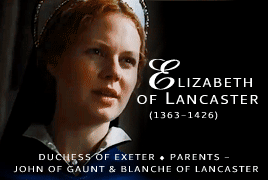
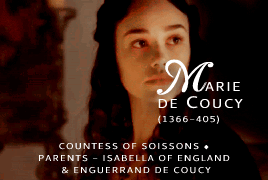

ROYALTY MEME | Granddaughters of Edward III & Philippa of Hainault (part one)
through their children: Lionel of Antwerp, John of Gaunt, and Isabella of England
#historyedit#historicwomendaily#philippa plantagenet#philippa of lancaster#elizabeth of lancaster#marie de coucy#philippa de coucy#edward iii#philippa of hainault#history#women in history#weloveperioddrama#cortegiania#userperioddrama#perioddramaedit#userbennet#perioddramasource#onlyperioddramas#*royalty meme#my edit
114 notes
·
View notes
Text
The Samhain Rising erupted in Ireland on October 15, 1912. With the assistance of tanks originally embarked for France, the rebels in Dublin were put down decisively by British forces under Mary of Teck, on October 25, 1912.

British Mark V tank used as a battering ram during house to house searches in Dublin on 18 January 1921
#Mark V#british armor#british tanks#October 1912#1912#10.15.1912#10.25.1912#Battle of Neville's Cross#Ireland#Scotland#Samhain Rising#Mary of Teck#Philippa of Hainault
94 notes
·
View notes
